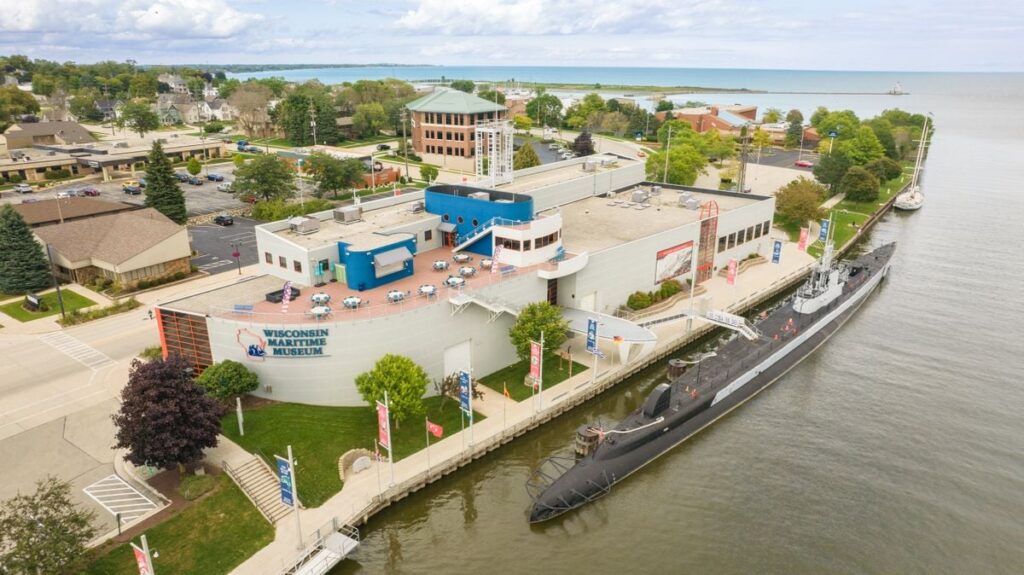The USS Cobia floats in the Manitowoc River outside the Wisconsin Maritime Museum.
Wisconsin Maritime Museum
From lighthouses to baseball stadiums, globetrotters have no shortage of unique accommodations to choose from while traveling.
But history buffs may find one experience particularly intriguing: staying on a fully restored World War II-era submarine—including the very same bunk beds American sailors slept in during war patrols. Intrepid travelers can do just that at the Wisconsin Maritime Museum, which has made its submarine, the USS Cobia, available for overnight stays.
Called the “Sub Bnb,” the unusual floating lodging is available for booking on Airbnb. The sub can accommodate more than 16 guests at a time, thanks to the 65 sailors’ bunk beds scattered throughout the vessel. The only room that’s off-limits to sleeping? The captain’s quarters—but visitors can still take a look around, per Business Insider’s Talia Lakritz.
During World War II, the Manitowoc Shipbuilding Company built 28 freshwater submarines for the U.S. Navy.
Wisconsin Maritime Museum
“Your stay will be as unique as the submarine,” according to the listing. “No two visits are exactly alike. With more than 50 different places to sleep, you get to choose your own adventure on USS Cobia.”
Guests can explore the submarine on their own, but a behind-the-scenes tour is also included with each stay. Because the vessel is only accessible through the museum, guests also have after-hours access to the facility—including all the exhibits and the theater, where they’re invited to screen maritime and submarine movies from the museum’s collection.
Guests can choose from 65 bunk beds during their stay aboard the USS Cobia.
Wisconsin Maritime Museum
Visitors can book the submarine for multiple nights in a row, but they’ll have to pack up their belongings each morning because the USS Cobia is open to all museum visitors during the day.
Named after a large fish found in warm seas around the world, the USS Cobia was commissioned on March 29, 1944, with Lieutenant Commander Albert Lilly Becker in command.
Over the course of two years, the 312-foot submarine completed six war patrols and sank 13 Japanese vessels—including an enemy convoy headed to Japanese-controlled Iwo Jima.
“U.S. Marines considered this sinking critical to their success in capturing Iwo [Jima] six months later,” according to the museum.
In 1970, a group of local veterans brought the USS Cobia to Manitowoc, Wisconsin, to serve as a memorial to submariners. That memorial later became the Wisconsin Maritime Museum, a 60,000-square-foot venue with exhibits, model ships, an operating steam engine and other artifacts.
Overnight visitors also get after-hours access to the museum.
Wisconsin Maritime Museum
Manitowoc was an important site during World War II. An estimated 7,000 men and women worked around the clock at the Manitowoc Shipbuilding Company, which constructed 28 freshwater submarines for the U.S. Navy. The USS Cobia was not built in Manitowoc, but it serves as a symbol of the city’s shipbuilding heritage nonetheless; it’s also a tribute to all the men and women who have served on submarines on behalf of their country.
In addition, the USS Cobia is “identical” to some of the freshwater submarines built by the Manitowoc Shipbuilding Company, as Karen Duvalle, the museum’s submarine curator, writes in the Herald Times Reporter. That’s because the company initially used blueprints from the Electric Boat Company, where the USS Cobia was constructed.
Starting in 1996, the USS Cobia was restored to its 1945 configuration—a massive undertaking that included installing World War II-era flooring, bunk beds, crew lockers and more. In more recent years, staff and volunteers have also restored several of the submarine’s systems and components, including two of the main engines.
The museum is currently raising money for a comprehensive inspection and preventative maintenance work, which is slated to take place in September 2025 at a shipyard in Sturgeon Bay, Wisconsin. Staffers estimate that it costs $150,000 a year to protect and preserve the USS Cobia as it floats atop the Manitowoc River. They’re trying to raise an additional $1.5 million for the upcoming dry dock project.
“Cobia is one of the best-preserved submarines or museum ships in the country,” Duvalle told FOX 11 News’ Eric Peterson last year, adding: “It’s always been in good hands here, which is why we want to continue that tradition and dry dock.”
Scout troops and youth groups can also spend the night aboard the fully restored submarine.
Wisconsin Maritime Museum
In the past, the Wisconsin Maritime Museum has invited scout troops and other youth groups to stay on the USS Cobia. When groups were no longer permitted to gather during the Covid-19 pandemic, the museum began making the submarine available to individuals and families. The idea was a hit.
“It’s one thing to walk through a World War II submarine on a guided tour and imagine what life was like on board,” writes Business Insider. “It’s another to fully immerse yourself in the experience by eating where they ate and sleeping where they slept.”


